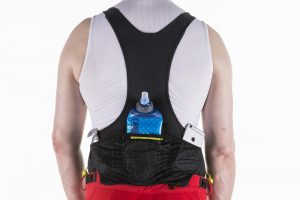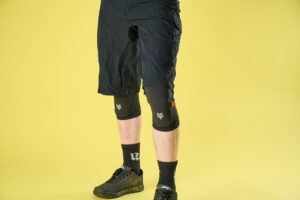Tenacious grip and better rolling resistance should be a winning formula for enduro racing
Michelin’s Wild Enduro is the privateer’s choice, but will the new V2 roll any quicker?
The new Michelin Wild Enduro tyre is completely new for 2024, it’s lighter than the generation is replaces and there are also claims it rolls faster too. And with two front end models – MS (Mixed/Soft) and MH (Mixed/Hard) – and a Rear only specification, it looks like the french rubber brand has options for gravity riding in most conditions.
Of course the legendary French tyre brand Michelin needs little introduction. It’s been deeply involved in MTB enduro and DH racing for years and tyres bearing its chequered ‘Racing Line’ logos have won multiple EWS Enduro World titles under Sam Hill.

The new Wild Enduro is more subtle than the original, with grey sidewalls, but the unflinching grip remains
The previous generation Wild Enduro was widely specified as OE (original equipment) on many new bikes and a popular choice for privateer racers and UK shredders. It’s sticky grip meant I’ve used pretty much every generation and model of Michelin’s gravity line up over the last two decades and it was really only the weight and rolling resistance that kept it from being one of our best mountian bike tyres.
Design and specifications
Aside from an all-new tread pattern that’s simultaneously more open and toothier than the previous Michelin Wild Enduro, the all new Racing Line models switch from a 4-ply DH shield casing to a dual-ply carcass.
This new casing is lighter and more supple, while hopefully retaining good puncture protection by using two separate woven liner shields and a bead bumper to resist pinch flats. One of these ‘Kevlar-style’ layers covers just the tread crown and the other wraps the entire tyre.

Edge lugs run continuously around the tyre now, which makes it more precise and predictable
Both MS and MH models fill in some of the blanks on the previously too widely-spaced edge blocks that I whinged about when reviewing the old Wild Enduro front tyre, should it should be better when supporting rider weight in loose dirt and loam.
Targeting Mixed/Soft conditions explains why the MS has a reasonably open tread that should also cut in better in loose conditions and mud, but it’s still a good way off a dedicated spiky mud tyre and actually pretty versatile. I used it in a mix of slick UK dirt and then bone-dry Mediterranean rocks and it worked well on both and the tread pattern roughly equates to something like a slightly more spaced out ‘standard’ tyre like a Schwalbe Magic Mary than a Shorty or anything.
Michelin also has more tricks up its sleeve beyond new tread patterns with its latest Magi X rubber blend reformulated to offer better performance at lower temperatures. Old Michelins had a bad rep for getting overly stiff and pingy on wet rocks and roots when the thermometer dropped, but I’ve not been able to test this aspect yet with receiving the tyres in spring rather than winter.
The new rubber formula is also supposed to roll significantly faster, which I did notice immediately and it’s really welcome. Michelin says “Magi-X technology reduces rubber-related energy losses, meaning that every turn of the pedals counts more. Independent testers Wheel Energy have shown the new tyres deliver significant improvements in rolling resistance with the rears saving 30W over the previous versions and the front tyres 20W, presenting serious speed advantages.”
This sounds to me like the tyre’s rubber compound isn’t as slow rebounding as the old models as this is a key aspect that can really effect how rubber absorbs rolling energy and momentum, but it’s always hard to decipher Michelin’s technology talk and I don’t know for sure either if the MS here has a softer compound than the MH tyre – I’m told it’s the same, but it definitely feels more squidgy to me.
The new Wild Enduros are also claimed 10% lighter than before, which is presumably mostly in the switch to the new dual-ply 55TPI construction that ‘minimises flexion movement for superior stability when cornering and landing after jumps’ according to the brand.

The original Michelin Wild Enduro Racing Line tyre was slow and heavy
Performance
Weighing the MS tyre before installing had me thinking how a tyre that weighs 1,320g can be significantly lighter, but checking back to my review of a previous generation 29in Wild Enduro front that tyre was a whopping 1,480g, so these new models really are a lot lighter, even if they’re still heavy.
Michelin’s dual ply casing is pretty tight and stiff to install and despite putting hundreds of tyres on with my bare hands over the years, I had to resort to tyre levers on a pair of carbon wheels (I just about got them on alloy rims by hand). One bonus of this is the tyre popped into place a cinch with a track pump and never burped any sealant, even at around 20psi even on super rough DH tracks in San Remo.
I’ve only used the tyres so far in the UK and Italy in temperatures between around 6 to 25-degrees, so can’t comment yet on the advertised improvement in low temperature grip, but can say they do work well in both wet and dry conditions.
This new tyre’s touch and overall predictability is a big improvement over the previous model. When dirt is soft you can really push into the edges at hard lean angles for support on the ground and the shoulder holds a smooth line with no surprises or weird breakaway; this aspect alone is something I couldn’t do as confidently with the previous generation tread pattern.

The Maxxis Assegai is the tyre to beat in this category, with the optimum blend of speed and grip
MS grip is pretty continuous, more like a Maxxis Assegai than a Maxxis High Roller II or a similar tyre with a distinct grip channel, and the tread and rubber worked well in slimy conditions both on soft dirt and while hitting greasy roots at horrible angles and slinking across rocky wet passages.
Rolling resistance is noticeably better too. The MS tyre rolls over ‘OK’ with a sense of a what you’d expect slow and grippy tyre to be like rather than a ‘wading through treacle’ sensation previously served up on Michelin DH models. I even pedalled up a 2 ½ hour climb in the mountains without too much moaning, so they can’t be all that bad.
Despite being pretty open treaded, the new MS package of casing, tread and compound feels calm and stable on rock hard surfaces and can absorb big impacts landing rock steps or fast jumps without deflecting or buckling. The tyre isn’t even so solid it’s uncomfortable and overly stiff like the old wire bead DH 22 and 34 tyres were unless running really low pressures.

Those side lugs lay down a big footprint, which grips well on rocks and hard surfaces
There’s less ‘float’ here on rock hard surfaces than you can get with a tyre where central blocks have a bigger surface area like a Minion DHF. And you really push the MS, the central and side knobs have enough support so they don’t squirm or smear too easily when riding aggressively. There’s also tons of predictable support and braking traction where the tyre connects nicely without skipping or bouncing around too much slowing down.
With its new updates, Michelin has changed the character of its tyres for the better to the point they ride more like the Kryptotal Enduro R Soft from Continental. Whether that will cost the brand some of its core audience that loved the slappy, almost ‘medicine ball’ feeling of its previously dull and slow rebounding formula (at least in warmer weather) is hard to say though.
And, even with the slightly more dynamic ride, Michelin has retained a nicely damped feel in the casing though without sidewalls folding or twisting under high loads cornering or landing drops. This is backed up visually no excessive ply lines (light creases) in the casing, despite running around 20psi on the front of a long travel enduro rig on super long and rough tracks.

Tearing off a lug is not part of the Michelin plan, let’s hope it’s a one off
Finally, wear life seems pretty good (the tyre in the photo has done around 25,000m of descending on the front) but one significant issue I had with this Racing Line was ripping a shoulder tread block off completely. This is basically the end of the life of a very expensive tyre unless you start some glue work repairs, and, yes, it might be a one-off, but it’s something I’ve only ever done regularly to Schwalbe tyres in the past, so hopefully Michelin tyres won’t start doing this with the new casing and construction.
Verdict
The new Racing Line models are lighter, but despite the ‘enduro’ tag they are still comparable to Conti DH tyres and heavier than other brand’s enduro options like Maxxis DD. I also ripped a tread block clean off, which I’ve never done in a decade of testing older Michelin tyres. That aside, this Wild Enduro MS tyre rolls faster and grips better than the original, it delivers a win-win formula that should help you slay enduro stages. The tyre carries over Michelin’s excellent puncture protection and the casing is solid and stable without being too uncomfortable and unyielding. The MS also delivered decent wear life in very dry/rocky conditions with constant heavy braking.
















